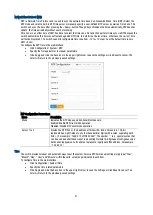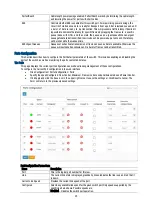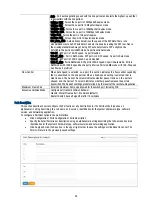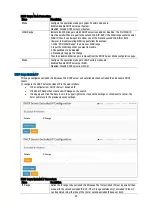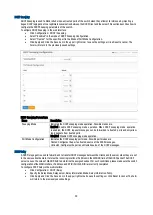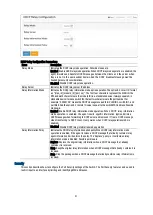
16
Non-standard cables.
•
Non-standard and miss-wired cables may cause network collisions and other network problems, and can
seriously impair network performance. Use a new correctly-wired cable. A category 5 cable tester is a
recommended tool for every 100Base-TX and 1000Base-T network installation.
Improper Network Topologies.
•
It is important to make sure you have a valid network topology. If you no longer experience the problems, the
new topology is probably at fault. In addition, you should make sure that your network topology contains
no
data path loops.
Check the port configuration.
•
A port on your Switch may not be operating as you expect because it has been put into a “blocking” state by
Spanning Tree, GVRP (automatic VLANs), or LACP (automatic trucking). (Note that the normal operation of the
Spanning Tree, GVRP, and LACP features may put the port in a blocking state.) Or, the port just may have been
configured as disabled through software.
Troubleshooting Chart
Symptom
Action
System LED is OFF
Check connections between the switch, the power cord and the wall outlet
Contact i3 Tech support for assistance.
Link LED is OFF
Verify that the switch and attached devices are powered on.
Be sure the cable is plugged into the switch and the corresponding device.
If the switch is installed in a rack check the connections to the punch-down block and patch panel.
Verify that the proper cable types are used and its length does not exceed specified limits.
Check the adapter on the attacked device and cable connections for possible defects. Replace the
defective adapter or cable if necessary.
Slow file transfer or
there is performance
degradation
Make sure that the attached device is set to auto negotiate. Both the port and the device must be on
the same setting (Auto, Half or Full Duplex).
Power and cooling problems
If the power indicator does not turn on when the power cord is plugged in, you may have a problem with the power outlet,
power cord, or internal power supply. However, if the unit powers off after running for a while, check for loose power
connections, power losses or surges at the power outlet. If you still cannot isolate the problem, the internal power supply
may be defective. Verify that all system components have been properly installed. If one or more components appear to
be malfunctioning (such as the power cord or network cabling), test them in an alternate environment where you are sure
that all the other components are functioning properly.
In-Band Access
You can access the management agent in the switch from anywhere within the attached network using Telnet and a web
browser. However, you must first configure the switch with a valid IP address, subnet mask, and default gateway. If you
have trouble establishing a link to the management agent, check to see if you have a valid network connection. Then
verify that you entered the correct IP address. Also, be sure the port through which you are connecting to the switch has
not been disabled. If it has not been disabled, then check the network cabling.




















